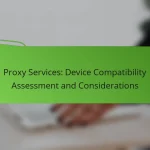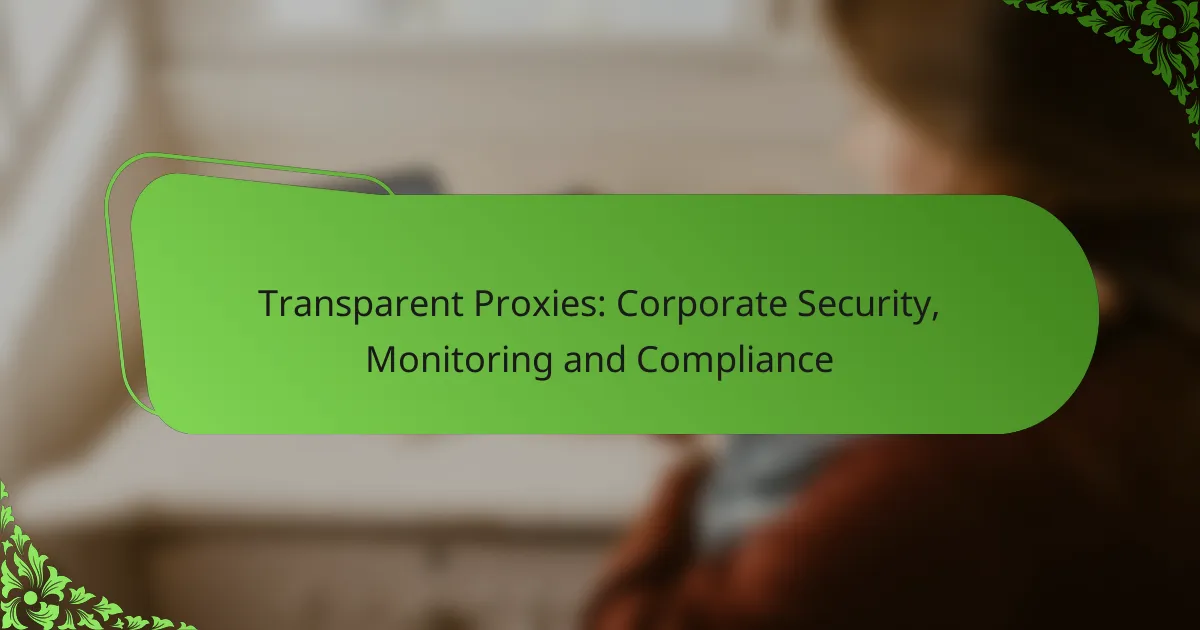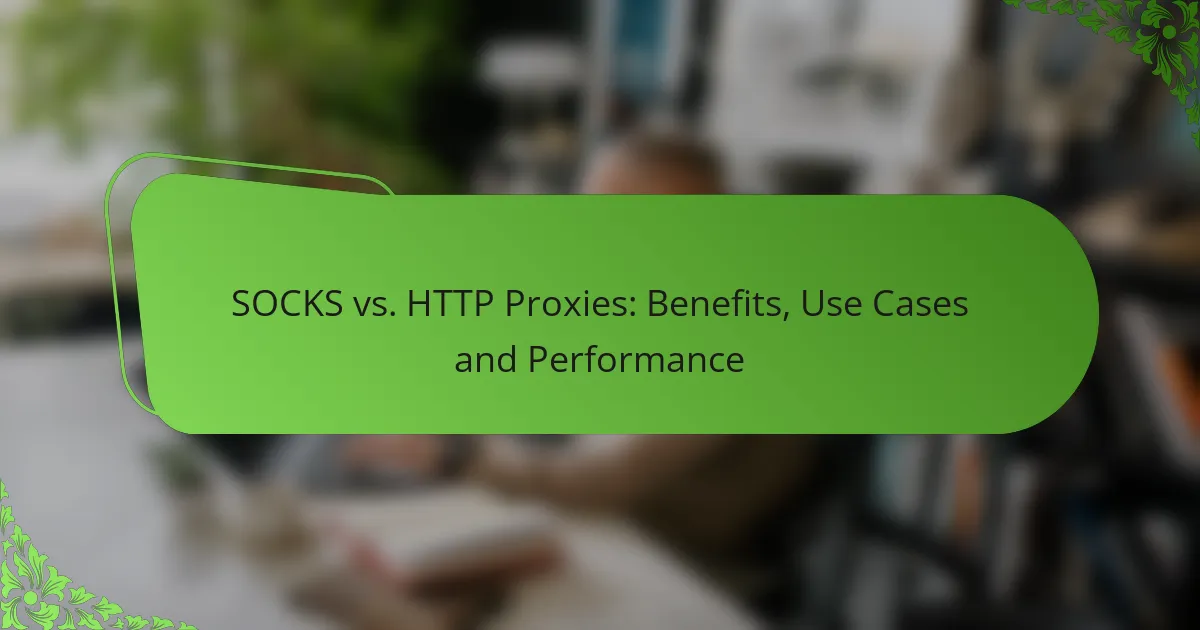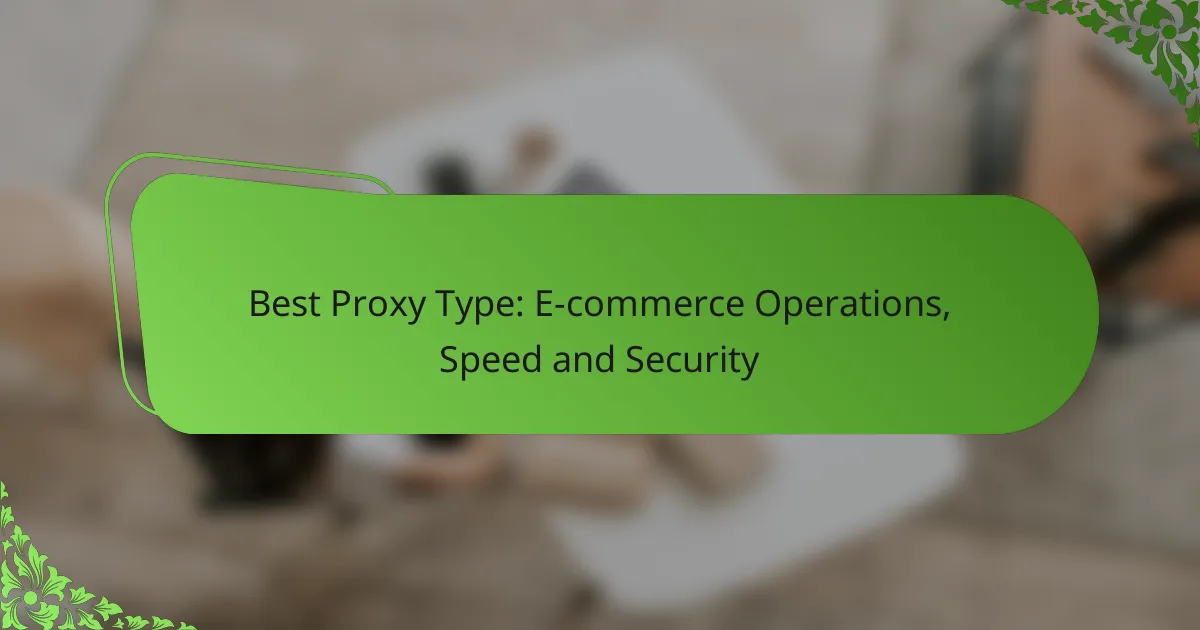Transparent proxies serve as vital tools for enhancing corporate security, monitoring, and compliance by acting as intermediaries between users and the internet without the need for client-side configuration. They enable organizations to protect data, detect threats in real-time, and ensure adherence to regulatory standards by analyzing network traffic and enforcing policies effectively.
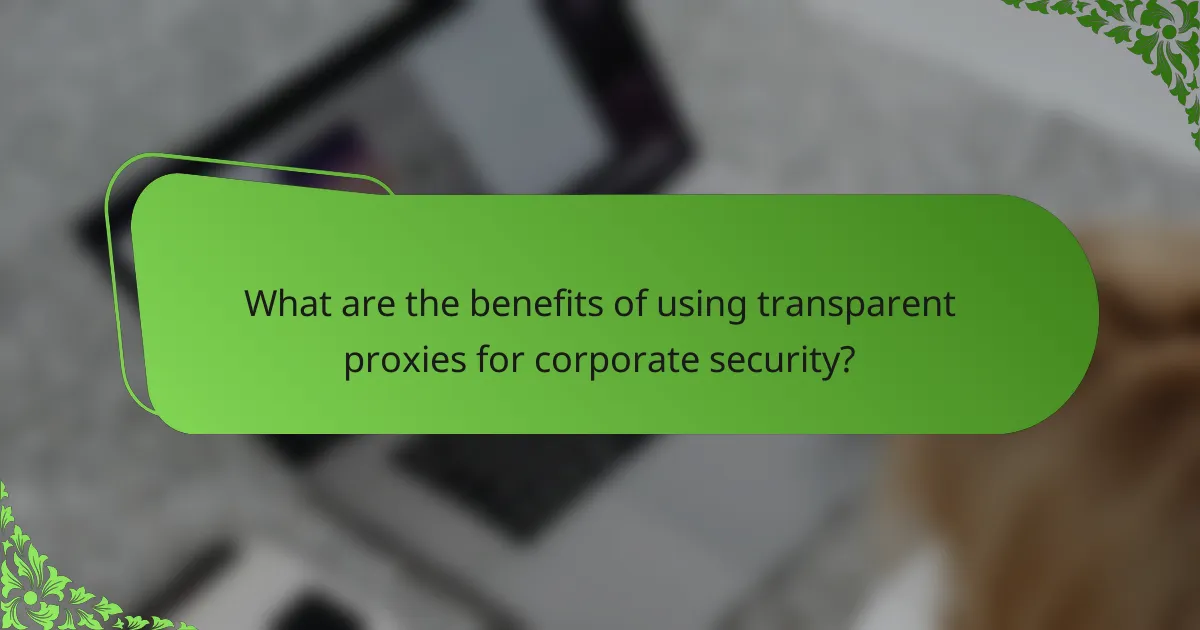
What are the benefits of using transparent proxies for corporate security?
Transparent proxies enhance corporate security by acting as intermediaries between users and the internet without requiring any configuration on client devices. They provide a range of benefits including improved data protection, compliance monitoring, real-time threat detection, and optimized network performance.
Enhanced data protection
Transparent proxies help safeguard sensitive corporate data by filtering out malicious content and blocking access to harmful websites. They can enforce security policies that prevent data leaks and unauthorized access, ensuring that only legitimate traffic reaches the internal network.
For example, organizations can configure transparent proxies to block file-sharing sites or social media platforms that may pose risks to data integrity. This proactive approach minimizes the chances of data breaches and enhances overall security posture.
Improved compliance monitoring
Using transparent proxies allows companies to monitor internet usage and ensure compliance with industry regulations. They can log user activity, which is crucial for audits and maintaining adherence to standards such as GDPR or HIPAA.
Organizations can generate reports on web traffic and user behavior, helping identify potential compliance violations. This capability not only aids in regulatory adherence but also fosters a culture of accountability among employees.
Real-time threat detection
Transparent proxies can analyze incoming and outgoing traffic in real-time, enabling immediate detection of suspicious activities. By employing advanced threat intelligence, they can identify and mitigate risks before they escalate into significant security incidents.
For instance, if a proxy detects unusual patterns, such as a sudden spike in data transfer to an external server, it can trigger alerts for further investigation. This rapid response capability is essential for maintaining a secure corporate environment.
Streamlined network performance
Transparent proxies can optimize network performance by caching frequently accessed content and reducing bandwidth consumption. This leads to faster load times for users and a more efficient use of network resources.
By minimizing the amount of data that needs to be retrieved from the internet, organizations can enhance user experience while lowering operational costs. Implementing a transparent proxy can result in noticeable improvements in network speed and reliability.
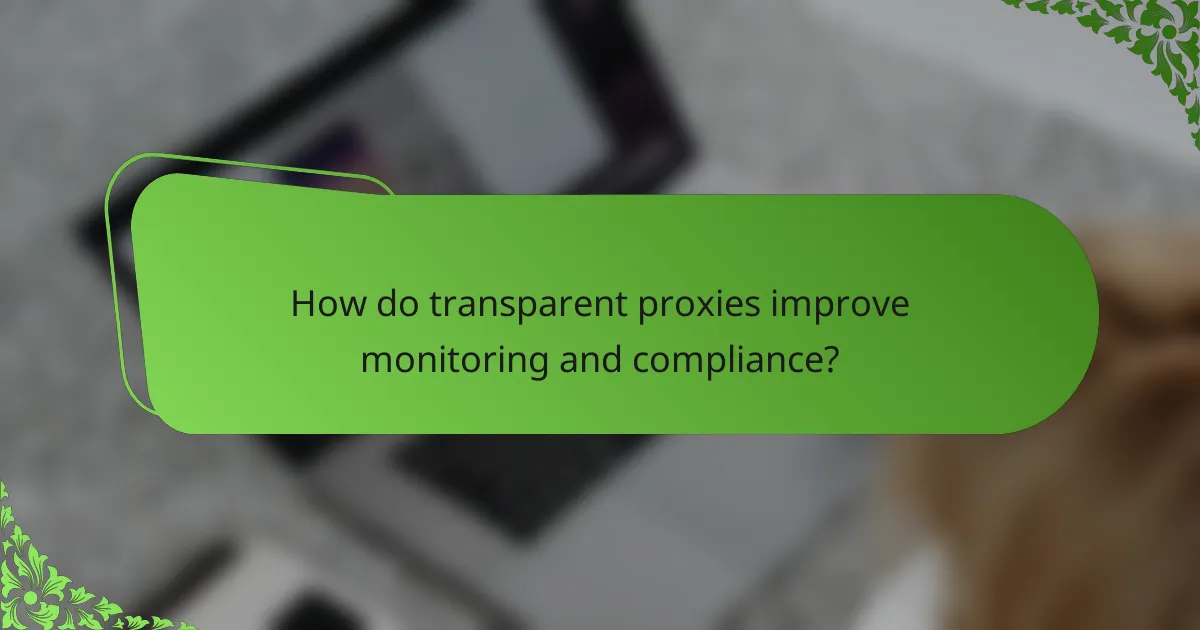
How do transparent proxies improve monitoring and compliance?
Transparent proxies enhance monitoring and compliance by intercepting network traffic without requiring user configuration. They enable organizations to analyze data flows and enforce policies effectively, ensuring adherence to corporate standards and regulatory requirements.
Centralized traffic analysis
Centralized traffic analysis allows organizations to monitor all network traffic from a single point. This setup simplifies the identification of unusual patterns or potential security threats, as all data passes through the proxy. By aggregating traffic data, companies can gain insights into user behavior and application usage, which aids in compliance audits.
Using tools that visualize traffic patterns can help teams quickly spot anomalies. Regular reports can be generated to assess compliance with internal policies and external regulations, such as GDPR or HIPAA.
Automated policy enforcement
Automated policy enforcement ensures that network usage aligns with corporate guidelines without manual intervention. Transparent proxies can automatically block or limit access to non-compliant websites and applications, reducing the risk of data breaches. This proactive approach helps maintain a secure environment while minimizing the burden on IT staff.
Organizations should regularly review and update their policies to reflect changing regulations and business needs. Implementing a tiered access system based on user roles can further enhance compliance and security.
Detailed user activity logging
Detailed user activity logging is crucial for tracking compliance and security within an organization. Transparent proxies can log every request made by users, providing a comprehensive audit trail. This data can be invaluable during investigations or audits, helping to demonstrate compliance with regulatory standards.
To maximize the effectiveness of logging, companies should establish clear retention policies and ensure logs are stored securely. Regularly reviewing logs can help identify potential security incidents before they escalate, allowing for timely intervention.
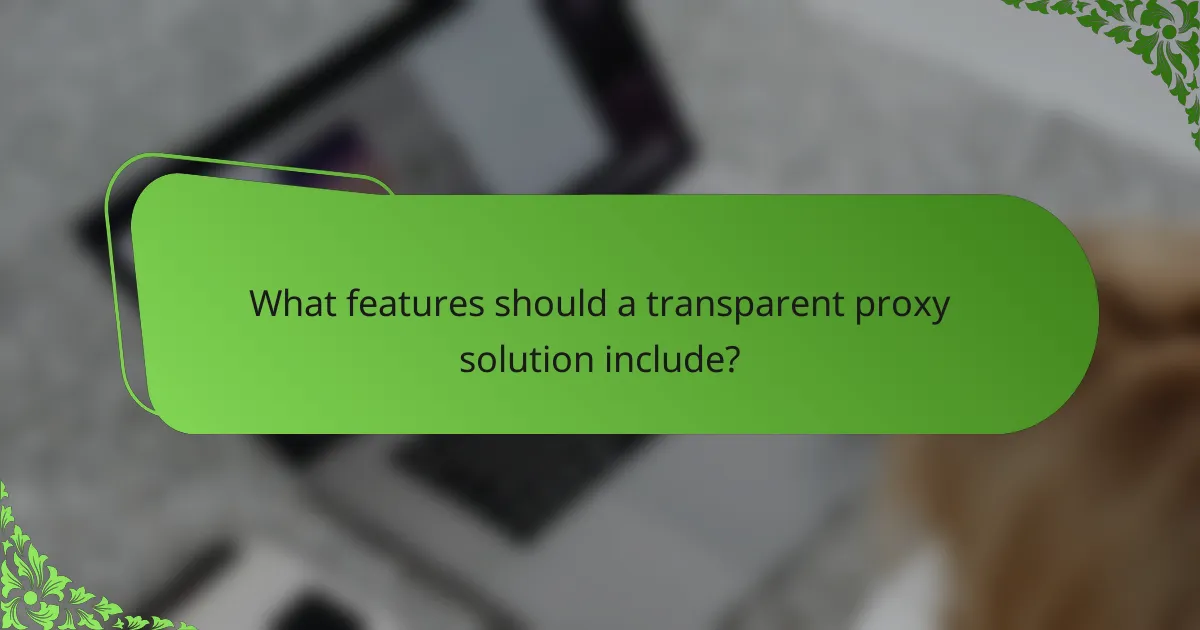
What features should a transparent proxy solution include?
A transparent proxy solution should include features that enhance security, facilitate monitoring, and ensure compliance with regulations. Key functionalities include seamless integration with existing security tools, scalability to accommodate large organizations, and a user-friendly interface for ease of management.
Integration with existing security tools
Effective transparent proxy solutions must integrate smoothly with existing security tools such as firewalls, intrusion detection systems, and antivirus software. This integration allows for a cohesive security posture, enabling organizations to leverage their current investments while enhancing overall protection.
When selecting a proxy solution, consider compatibility with your current technology stack. Look for solutions that support common APIs and protocols to ensure seamless data flow and interoperability.
Scalability for large organizations
Scalability is crucial for transparent proxies in large organizations, as they must handle increasing volumes of traffic without compromising performance. A scalable solution can expand resources dynamically to accommodate growth, ensuring consistent user experience and security.
Evaluate the proxy’s architecture to determine if it can scale horizontally or vertically. Solutions that offer cloud-based options or distributed architectures typically provide better scalability for organizations with fluctuating demands.
User-friendly interface
A user-friendly interface is essential for managing a transparent proxy effectively. An intuitive dashboard allows administrators to monitor traffic, configure settings, and generate reports with minimal training. This ease of use can significantly reduce the time spent on management tasks.
Look for features such as customizable dashboards, drag-and-drop functionality, and comprehensive help resources. A well-designed interface can enhance operational efficiency and improve response times to security incidents.
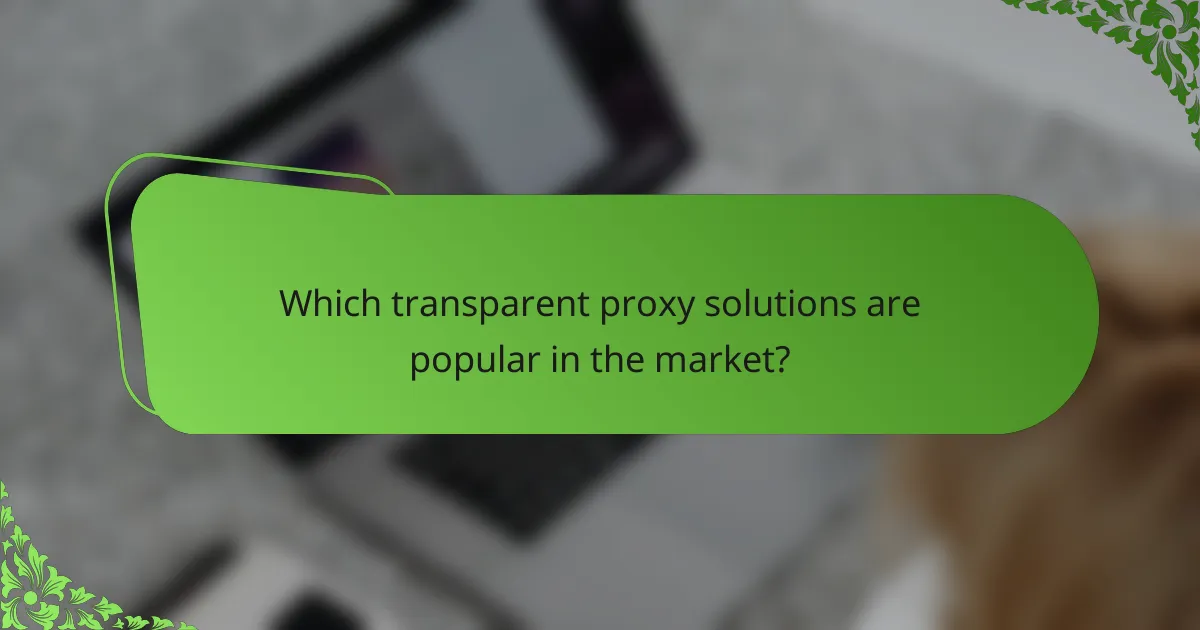
Which transparent proxy solutions are popular in the market?
Several transparent proxy solutions are widely recognized for enhancing corporate security, monitoring, and compliance. Popular options include Squid Proxy, SmartProxy, and Bright Data, each offering unique features tailored to different organizational needs.
Squid Proxy
Squid Proxy is an open-source caching and forwarding HTTP web proxy that is highly configurable and widely used in corporate environments. It helps improve web performance by caching frequently accessed content and can also enforce access policies to enhance security.
When implementing Squid Proxy, consider its compatibility with various operating systems and its ability to handle large volumes of traffic. Organizations often use it for content filtering, bandwidth management, and logging user activity, which aids in compliance with regulations.
SmartProxy
SmartProxy is a user-friendly proxy service that provides a large pool of residential IPs, making it ideal for web scraping and data collection without being blocked. It offers features like session control and geo-targeting, which can be beneficial for businesses needing to gather data from specific regions.
For companies looking to utilize SmartProxy, it’s essential to assess the pricing structure based on usage and the number of IPs required. This solution is particularly useful for marketing teams and researchers who need reliable access to web data while maintaining anonymity.
Bright Data
Bright Data, formerly known as Luminati, is a premium proxy service that offers extensive features, including residential, data center, and mobile proxies. It is designed for advanced web data extraction and provides tools for managing large-scale scraping operations.
When considering Bright Data, organizations should evaluate its pricing model, which can be on the higher end, but may be justified by the quality of service and extensive IP pool. This solution is particularly suited for enterprises needing robust compliance and monitoring capabilities in their data collection processes.
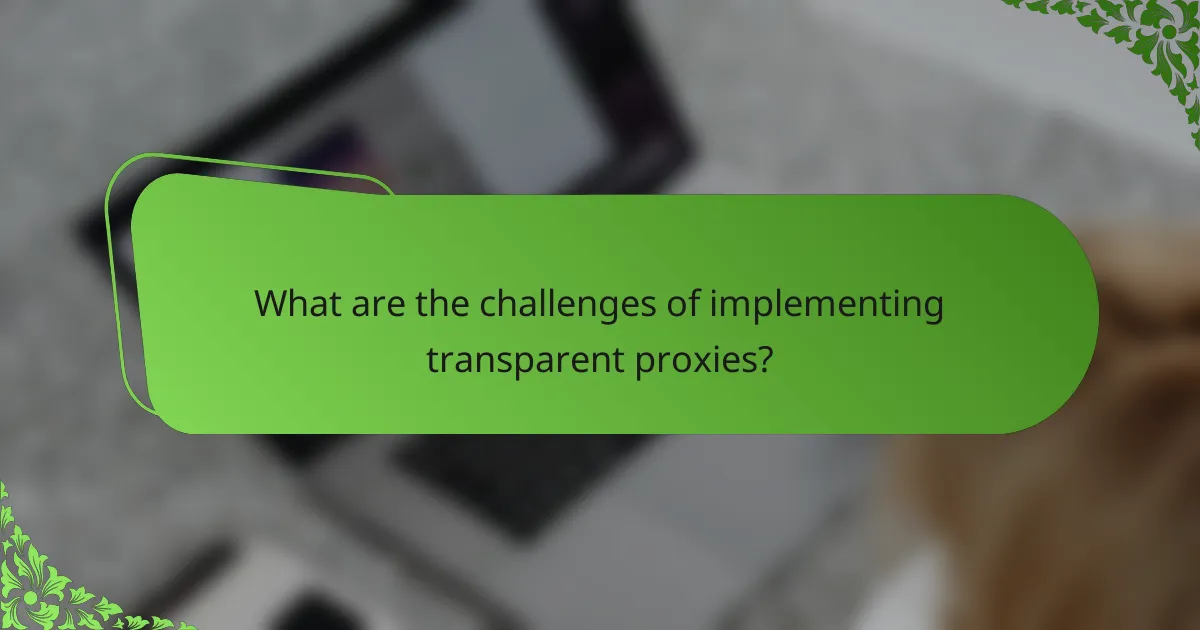
What are the challenges of implementing transparent proxies?
Implementing transparent proxies can present several challenges, including potential latency issues and compatibility with existing legacy systems. Organizations must carefully evaluate these factors to ensure effective deployment without disrupting network performance or user experience.
Potential latency issues
One of the main challenges with transparent proxies is the potential for increased latency. When data packets are intercepted and processed by a proxy, the additional steps can slow down communication, particularly if the proxy is not optimized. Latency can range from low tens of milliseconds to higher depending on the complexity of the filtering and monitoring processes.
To mitigate latency, organizations should consider deploying high-performance hardware and optimizing proxy configurations. Regular performance monitoring can help identify bottlenecks and allow for timely adjustments to maintain acceptable response times.
Compatibility with legacy systems
Transparent proxies may face compatibility issues with legacy systems that were not designed to work with modern proxy technologies. These systems might struggle with the additional layers of processing or may not support certain protocols, leading to disruptions in service. It’s crucial to assess existing infrastructure before implementing a proxy solution.
Conducting a thorough compatibility assessment can help identify potential conflicts. Organizations should consider phased rollouts or pilot programs to test the proxy’s impact on legacy systems, ensuring that critical operations remain uninterrupted during the transition.



